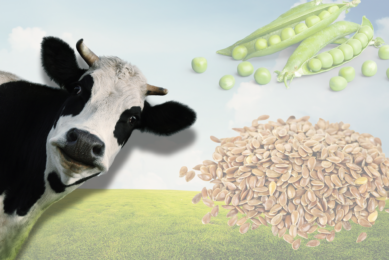Magazine edition 3: A focus on emissions and mastitis

In this 3rd edition of the year, Dairy Global magazine has put together a round-up of methane-reducing solutions currently available as well as research initiatives on this topic. In addition, as mastitis is consistently a hot topic on any given dairy farm, we bring you the latest on smart methods to tackle this disease. This and much more in this edition – take a look!
“We need a data-driven approach to enhance sustainability”
Following a new season of the video series Future Feed Talks, Dairy Global spoke with Ivo Lansbergen from dsm-firmenich about how data and precision farming solutions can support the industry to produce milk more efficiently and sustainably.
Global round-up: Methane-reducing solutions
By mid-2024, 6 of the world’s biggest dairy companies will begin publicly disclosing their methane emissions. At COP28, Danone, Nestle, General Mills, Lactalis USA, Kraft Heinz and Bel Group all agreed that by June or July this year, they would begin reporting emissions and developing reduction action plans. Here is an exclusive global round-up of products already on the market and those in development, as well as recent research initiatives into methane-reducing compounds.
Effective strategies to optimise silage quality
Silage quality, which impacts the nutritional value, safety and effectiveness of feed, poses a complex challenge. Base nutrition is determined by forage type and harvest timing, and further feed value is influenced by managing air and microbiology during fermentation, storage and feed out.

Feed and management: Proper calf care
Calf diarrhoea is a problematic disease due to its multi-factorial nature which affects calf performance and farm economies worldwide. Here we look at feed and management strategies that have a positive impact on the health of younger calves as well as calves in a later stage of life.
How can bacteria-based direct-fed microbials support your herd?
In previous articles, we presented an overview of the power of good bacteria for a dairy herd, explaining the potential benefits and how good bacteria can support animal health on a daily basis. However, most of the information we’ve previously shared focused on general features under laboratory conditions. This helps us understand the basics of these beneficial microorganisms, but does not provide an entire health picture of our animals. This article demonstrates how direct-fed microbials can impact your herd.
Achieve full feed potential from wholecrop silage
The need to preserve feed value and prevent further losses post-harvesting is greater than ever after months of exceptional rainfall has put crops under pressure. Yields of wholecrop silage across northern Europe are expected to dip by up to 20% this year.
World Dairy Expo 2024: The Golden Age
World Dairy Expo board president Bill Hageman tells us more about the upcoming event whichs takes place in Madison, Wisconsin, in October. He explains why ‘The Golden Age’ theme ties in with how the dairy industry has progressed with the latest technologies.

A family farm making Canada greener
Recently I’ve had the pleasure of visiting one of Canada’s largest single-site dairy farms in Ilderton, Ontario. At this 5-generation family farm, not only is the scale of the operation impressive but its commitment to the environment as well as its community is extraordinary.
Technology for precision feeding
In the modern era of dairy farming, efficiency and precision are paramount. With its numerous variables and operations, managing a dairy farm is complex. It requires innovative solutions that streamline processes and optimise performance. Here, we take a look at the latest version of DTM developed by Dinamica Generale, a cutting-edge tool designed to revolutionise how dairy farmers control their operations and KPIs.
Producing as an organic milk farmer in Denmark
Rising feed prices and other costs as well as a too low milk price are putting pressure on organic milk producers. We hone in on one organic farm to hear about its production and herd.
Hot silage: How to identify if it’s good or bad
Silage plays a crucial role in maintaining livestock health and productivity, and it is important to monitor its quality. One of the concerns with silage is its temperature. It’s important to understand that hot silage doesn’t always indicate a problem, but it’s essential to know how to differentiate between retained heat and aerobic spoilage. This article will help you understand the key points and practical methods for identifying the condition of your silage.
Protect cow performance by prioritising rumen health
Rumen health is essential for an efficient, productive, and healthy dairy herd. Here we discuss the impact of challenges to rumen wall integrity.
8 smart methods for detecting dairy cow mastitis
Conventional methods of mastitis detection are expensive, arduous, and require samples. Early mastitis detection is essential to minimise economic losses and ensure higher productivity and effective treatment. The recent advancement in technological and engineering tools and materials provides smart effective methods for the dairy industry to automatically detect mastitis.

Join 13,000+ subscribers
Subscribe to our newsletter to stay updated about all the need-to-know content in the dairy sector, two times a week.










